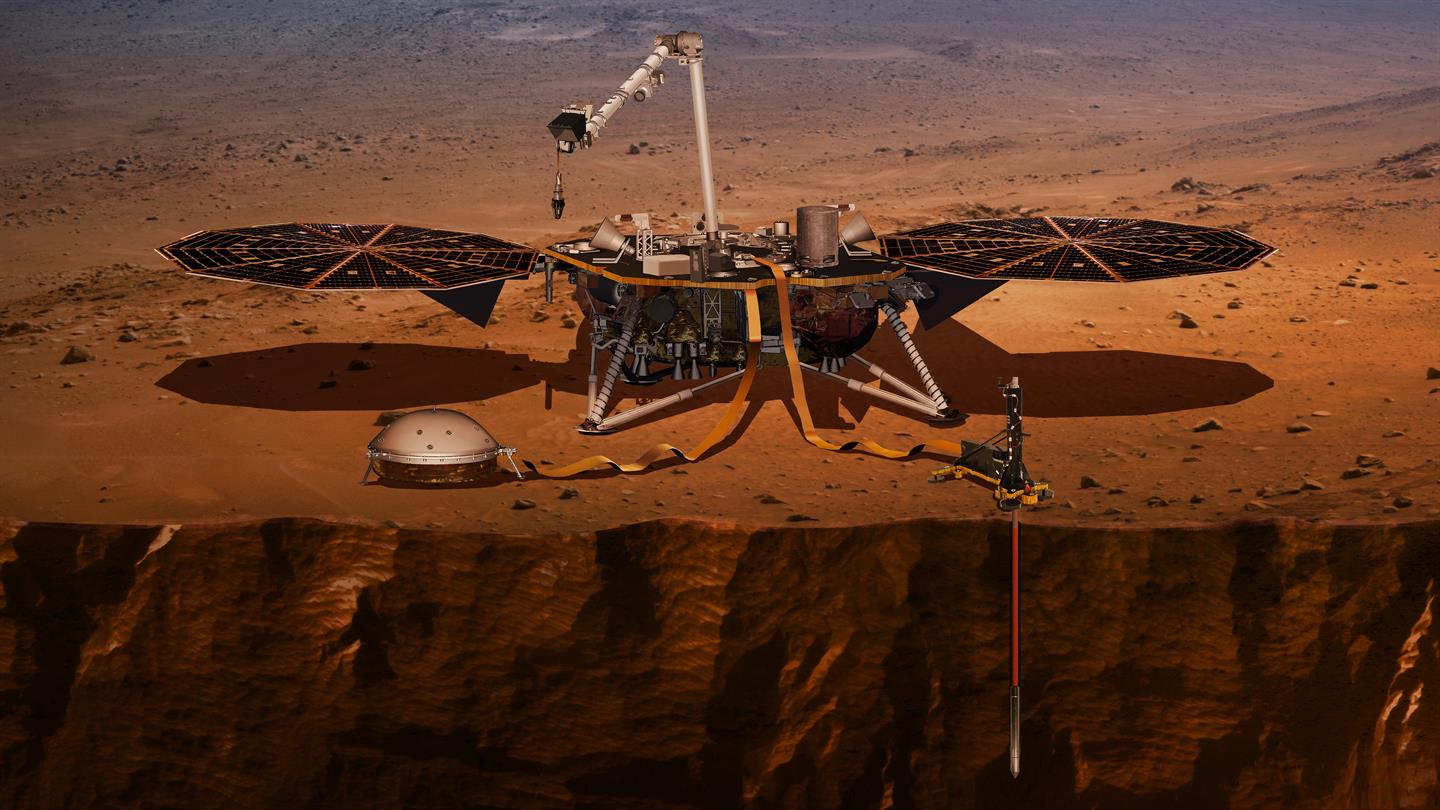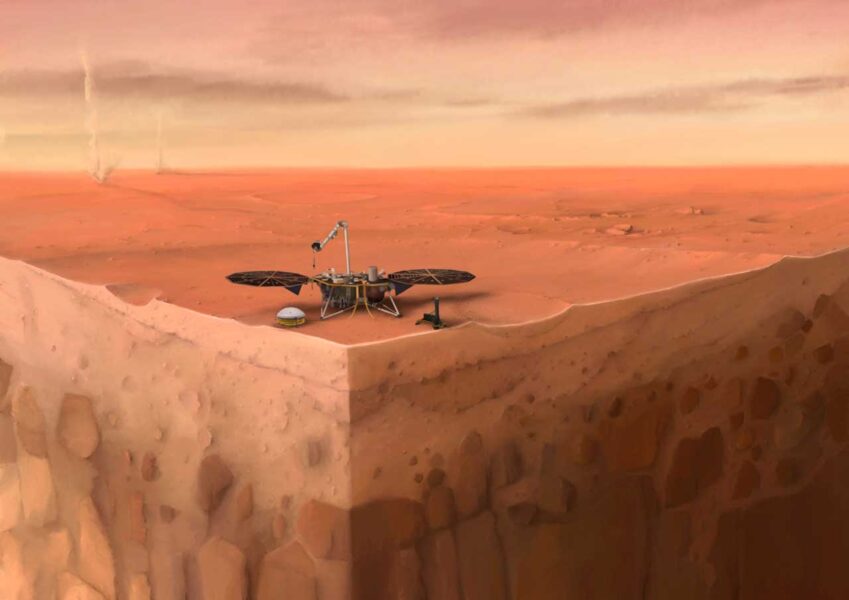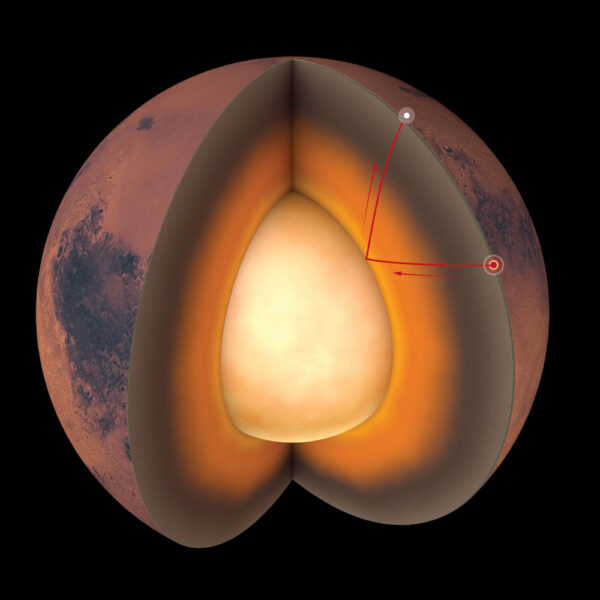The Mars Insight science team has used a handful of deep marsquakes to take stock of the Red Planet’s anatomy.

NASA / JPL
Roughly a century ago, scientists began using earthquakes as a window to our planet’s interior. Decades after that, Apollo moonquake measurements let scientists poke around the Moon’s insides. Now, we’re doing the same on Mars, with some surprising results.
NASA’s Insight mission touched down on the Martian surface in November 2018, and its seismometer (the Seismic Experiment for Interior Structure, or SEIS) has recorded 733 since early 2019. About 35 of these have been deeper quakes that scientists are now using to probe the planet’s anatomy.
Reporting in a trio of studies published in the July 23rd Science, the Insight science team has now analyzed a handful of marsquakes to make the first direct observations of the structure within another rocky planet. The results — a surprisingly thin crust, an undifferentiated mantle, and a larger-than-expected core — will help determine how Mars formed and evolved.
Thin Crust vs. Thick Crust
Before Insight, scientists were limited to assessing the Martian crust from orbit. Satellites observed the gravitational pull as they circled the planet, which would increase slightly as they passed over thicker crust. Those measurements gave a sense of the relative thickness of the crust, but marsquakes had the potential to make the first absolute measurement.
But measuring marsquakes wasn’t just a matter of sending a lander to Mars; in a sense, the scientists also had to wait for the planet to come to them.
“If you're waiting for quakes; you need to wait until a quake occurs,” says team member Simon Stähler (ETH Zurich, Switzerland). “Of course, when you're in the middle of the situation, it can feel as if ‘Oh my god, it's not working!’”

IPGP / Nicolas Sarter
“It was certainly very exciting (and at times tense) to wait for the first seismic event to be detected by InSight on Mars,” says Brigitte Knapmeyer-Endrun (University of Cologne, Germany), co-investigator of the SEIS instrument. That event was announced on April 23, 2019 — but it wasn’t even the right kind. The team had to wait several months after the seismometer’s deployment before a shake occurred at a low-enough frequency that indicated it was had traversed the crust’s full extent.
But that one quake already showed what additional deep quakes would confirm: The crust was thinner than expected.
Just how thin remains an open question. At first, analysis seemed to show that the Martian crust had two layers and was only 20 kilometers (12 miles) thick beneath the Insight lander. “This was thinner than any models had predicted,” Knapmeyer-Endrun says. Additional events and analysis showed that the crust could have an additional layer, making it twice as thick (39 km), somewhat closer to expectations. (Both options are on the thin end compared to Earth’s continental crust, which is typically 35 to 70 km thick.)
Insight data cannot yet distinguish between the two possibilities. “We are definitely hoping to resolve the ambiguity, either by analyzing more data or by using new methods to analyze the existing data, but we are not there yet,” Knapmeyer-Endrun adds.
Though the crust only makes up the top 1% or so of Mars, its exact thickness would shed light on the planet’s formation. As the first part to solidify as the completely molten planet cooled, the crust carries the “memory” of that early time in its composition. A thin crust would have to have an unexpectedly high proportion of radioactive, heat-emitting elements. Gamma-ray spectroscopy from orbit has shown that the surface is not so highly enriched in radioactive elements, so they’d have to be buried deeper in the crust, just above the mantle. The radioactive composition of a thicker crust, on the other hand, would match surface observations.
“If the thinner crust proves to be true, it would be very surprising indeed,” says Doris Breuer (DLR, Germany), who was not involved in the study. “A thin crust will raise many questions about how it was formed and what this means overall for the thermochemical evolution of Mars.”
Going Deep
Compared to the relatively thin crust, Amir Khan (ETH Zurich, Switzerland) and colleagues find that the mantle of Mars extends much deeper, down to 400 to 600 km (about twice as deep as on Earth, relatively speaking). What’s more, marsquakes show it’s a simple, undifferentiated structure.
There are two layers to Earth’s mantle: the upper one is geologically similar to the mantle on Mars, while the lower one is dominated by bridgmanite, a mineral not stable on Earth’s surface. The transition region between the lower and upper mantles acts like an insulating blanket, keeping the core from losing its heat. Without this lower layer, Mars loses heat from its core more quickly than Earth does.

Chris Bickel / Science
Nevertheless, the Insight data show that Mars’s core is still fully liquid, as expected. With the analysis of six marsquakes that were coming in toward Insight at just the right angle, Stähler and colleagues find that the core is on the larger end of what previous indirect measurements had suggested, between 3,580 and 3,740 km across.
Such a large core must be less dense than previously thought, which suggests it contains an unexpectedly high proportion of lighter elements such as sulfur, oxygen, carbon, and hydrogen. A larger, lighter core probably doesn’t have a solid inner part as Earth does.
It may seem surprising that Mars lacks a global magnetic field despite its liquid core. But the dynamos that drive planetary magnetic fields are complicated beasts, and they need to be fed.
Earth’s solid inner core provides that fuel by releasing heat as it crystallizes, which churns the outer core and drives the production of the magnetic field. Mars, on the other hand, probably drove its global field through the release of the intense heat of its formation. That would only have lasted a few hundred million years, consistent with surface observations showing that the global field shut down between 3.7 billion and 4.5 billion years ago.
It’s still possible that Mars's global field could revive under certain conditions, such as if the inner core were to crystallize, or if iron were to “snow out” near the core’s boundaries. But what the future holds for Mars’s magnetism depends on more exact measurements of just how many light elements there are in the core, Stähler and colleagues point out.
Challenges Along the Way
Insight’s groundbreaking measurements haven’t been without their share of difficulties: First, unlike on Earth and even the Moon, there’s only one seismometer on Mars, which makes triangulating quake sources more difficult.
Second, marsquakes are relatively weak compared to some of those on Earth, and the winds are strong. Scientists learned that the hard way with the failed seismic experiment that sat unshielded on top of the Viking 2 lander. SEIS has a cage around it to block the wind, but even so, quakes are harder to sense during the blustery Martian winters.
Then there were the quakes themselves: Of the more than 1,000 quakes, most were weak and shallow shakes. The useful quakes came from beneath the crust, usually from activity near Cerberus Fossae, a fissured area where the crust is pulling apart. Turns out, the large core creates a sort of seismic shadow, blocking most of the quakes that would come from elsewhere on the planet, such as the Tharsis Rise region.

NASA / JPL-Caltech
(Meanwhile, another Insight’s instrument, the heat probe “mole,” was facing its own share of difficulties, which turned out to be insurmountable. That part of the mission ended last January and it never took complementary measurements of the planet’s heat loss.)
To make maximum use of the marsquakes they did detect, the teams behind all three studies used multiple, independent analysis methods. Stähler credits the unusually large teams with making this possible.
Two-thirds of the scientists, he says, were terrestrial seismologists who had never worked with data from another planet before. “Before the landing, they had ideas of what would work on Mars,” he says. “And then the Martian data was, well, it was different, it was complicated.” The scientists had to scrap some ideas and adapt others in order to look inside Mars.
Extended Mission
NASA recently extended the Insight mission through the end of next year, past the current Martian winter when marsquakes are difficult to detect due to high winds. Despite a dust-fueled energy crisis earlier this year, the solar-powered lander has since regained some power-generating capacity. “We are at least safe for this season’s winter and probably far into 2022,” Stähler says. During that timeframe, the scientists expect Insight to detect another 10 of the high-quality, low-frequency quakes that enable them to delve deep into the planet.

NASA / JPL-Caltech
Some marsquakes would be particularly exciting to detect: For example, a quake of magnitude 4 or more would help Stähler look for (or rule out) a solid inner core. And a shake moving along the planet’s surface would help Knapmeyer-Endrun resolve the ambiguity about the crust’s thickness by enabling measurements not just at Insight itself but all along the path between the lander and the quake’s epicenter.
Ultimately, only time will tell what the planet will deliver.
References:
Cottaar S. & Koelemeijer P. "The interior of Mars is revealed." Science, July 23, 2021.
B. Knapmeyer-Endrun et al. "Thickness and structure of the martian crust from
InSight seismic data." Science, July 23, 2021.
A. Khan et al. "Upper mantle structure of Mars from InSight seismic data." Science, July 23, 2021.
S. Stähler et al. "Seismic detection of the Martian core." Science, July 23, 2021.
 2
2









Comments
Anthony Barreiro
July 22, 2021 at 9:39 pm
This is fascinating! As we understand Mars better, it gives us a new perspective our own precious planet. I hope the success of the Insight mission will inspire plans to send more seismometers to Mars. Four landers in a tetrahedral arrangement would seem to be a good next step. And gnarlier drills for the heat probes.
You must be logged in to post a comment.
Anthony Barreiro
July 22, 2021 at 9:42 pm
P.S. The radius of Mars is about 3400 km. Earth radius about 6400 km.
You must be logged in to post a comment.
You must be logged in to post a comment.